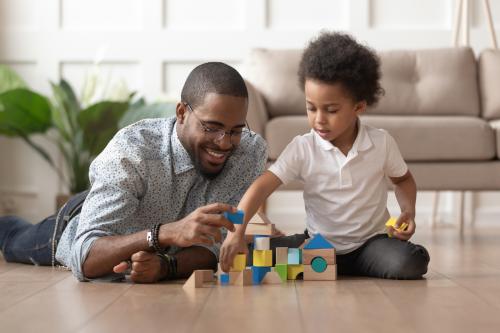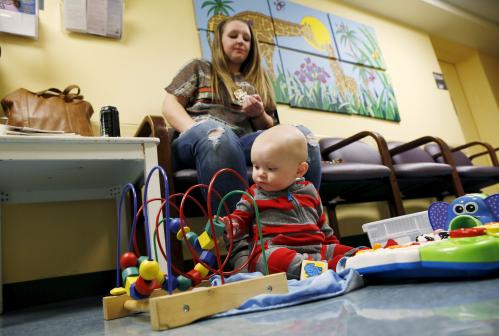In the recent Democratic presidential debate, Joe Biden was asked about our nation’s history of slavery and pervasive inequality in its schools. He gave a meandering response that received a lot of attention—and criticism.
That criticism was warranted. Biden’s response was fundamentally problematic in that he failed to address the legacy of slavery or acknowledge structural forces of inequality in the U.S. It had other, less troubling issues, too. Record players aren’t only outdated, even their modern counterparts won’t create a healthy language environment that promotes brain development, as Vice President Biden seemed to suggest.
But, as a pediatric surgeon who performs cochlear implants and social scientist who studies children’s early language environments, I believe that Biden’s response—despite its flaws—presents an important opportunity. This is an opportunity to raise awareness about the life-altering power of parent language and interaction in a child’s earliest years.
The “word gap”
Once the Twittersphere had expended its best record-player jokes, much of the discussion about Biden’s comments turned to the fact that he had referenced the “word gap,” or the notion that children from poor households hear millions fewer words than their peers from affluent households.
As many readers of this blog are aware, this idea comes from a 1995 study conducted by child psychologists Betty Hart and Todd Risley, which found that children in lower socio-economic homes heard far less language than their counterparts in higher socio-economic homes. They estimated the size of the “gap” to be 30 million words by age four. In recent years, and especially in the days since the Democratic debate, the merits of this study have been called into question.
I recognize and readily acknowledge the shortcomings of the Hart and Risley study; issues with the research design and with the framing of its results as a gap, or deficit. But I also credit it, and its relative simplicity, with helping me–and many others–begin to understand not just the role of language in child development, but the power of parents and environments to help shape child development in profound ways. Brain development, cognition, and poverty are undeniably complex issues. If I hadn’t encountered Hart and Risley’s study, I may still be spending all of my time in the operating room, wondering why some of my patients thrive after receiving a cochlear implant and others struggle. But I quickly learned that their study, while groundbreaking, was merely the first sentence in a robust scientific narrative about the impact of language on foundational brain development—research that goes way beyond the word gap.
I also understand the need to move beyond the idea, or even metaphor, of a 30-million-word gap. That is why the name of research center I lead at the University of Chicago has changed from “Thirty Million Words” to “The TMW Center for Early Learning + Public Health,” conveying a more evolved and accurate understanding of the science. Just as our name has changed, it is time for the public discussion around the word gap to evolve.
Looking beyond the gap: Emerging research on language and brain development
The key, I think, to that evolution is cutting-edge neuroscience that clearly demonstrates that the early language environment is the catalyst for healthy brain development. Just as an infant needs physical nourishment in the form of milk to grow and thrive, they need social nourishment in the form of language to ensure intellectual growth.
Neuroscience has evolved tremendously in recent decades. What was once based on inference can now be scientifically investigated using brain imaging and the power of computational science. As a result of these advancements, pioneering scientists have filled the gap in understanding how parent or caregiver input impacts the brain, and ultimately a child’s skill formation. They have generated a wealth of evidence that suggests the single most important component to brain development is the relationship between a baby and her caretaker, with parent language at the heart of that relationship. Parent language, it is important to note, refers not just to the words a parent speaks to a child, but also the quality of the parent-child interaction.
The linguistic serve-and-return in the baby-caretaker relationship is a key factor in learning. Its importance cannot be emphasized enough. This is why Biden’s suggestion that playing a record player at home will help a child learn is not accurate. A fascinating study by Dr. Patricia Kuhl demonstrates this point. Her team exposed nine-month-old American babies to Mandarin, with half of the babies hearing it from mother figures who combined the language with cuddles and warmth. The other babies heard exactly the same Mandarin, also spoken with motherly warmth, but via an audio recording or video device. After 12 visits, the babies who heard the language from live individuals were able to identify the sounds of Mandarin while the other babies could not.
Two more recent studies, both of which utilized cutting-edge tools to record language and sophisticated brain imaging, found that “conversational turns” with adults were correlated with more activity in relevant parts of the brain and children’s scores on standardized tests of language skill. Both studies found that the effect of conversational turns was greater than the effect of the number of words heard.
Parent language, understood this way, has been found to influence an individual’s ability to reach their fullest potential in math, spatial reasoning, and literacy, their ability to regulate their behavior, their reaction to stress, their perseverance, and even their moral fiber. It is an essential catalyst in determining the strength and permanence of certain neural wirings.
The period from birth to age three is especially critical to this process. Unlike any other organ, the brain is unfinished at birth and its development is dependent on two major factors: genetics and early experience, and their lifelong effects on one another. While genetics supply our basic blueprints, science strongly indicates that achieving the potential included in the blueprint, no matter how incredible, is largely determined by a child’s earliest language environment. No one would question that the architectural plans you have for your dream home are pretty meaningless without an excellent contract team or quality materials.
Putting research to use
All parents and adults in our society, then, must understand that a word is not simply a word; it is a building block for a child’s brain. We know the impulse to love, nurture, and protect our children is embedded deep within our DNA. But does that mean we’ve also been hardwired with the essential information to grow children’s brains? Of course not. We, as a society, must prioritize making the information available to all families.
Of course, we need to do more—much more—than make sure that parents have an equal chance to learn the science. This goes way beyond telling parents, “go talk to your kids.” We need policies that afford parents equal opportunity to put that knowledge in action—policies that support parents in their most important role as the key architects of their children’s brains. Without social policies in place to mitigate and address the causes of poverty, to reduce structural inequality, to empower families, we will fail to harness the incredible power of what we know to be true about building healthy brains and healthy children.
I am glad we are having this national dialogue. Because the more parents, caregivers, policymakers, and adults recognize the role that parents and the power of their talk play in early brain development, the better.
So, go ahead and dust off that record player and put on a 45. Just make sure to also dance, sing, and interact with your child when you do so. The results could be profound.







Commentary
What cutting-edge neuroscience tells us about early childhood development
September 26, 2019